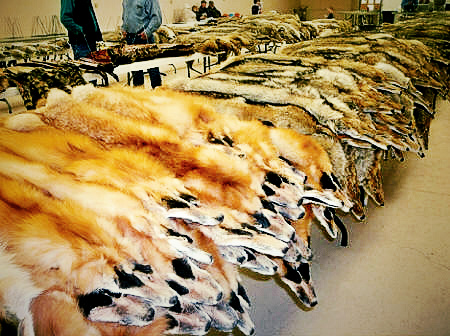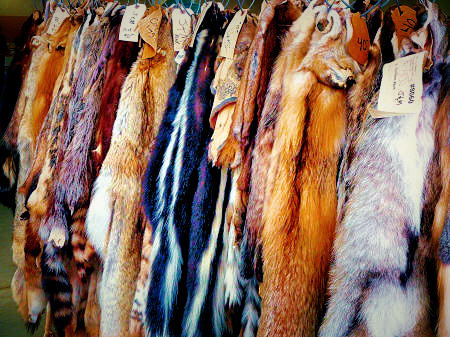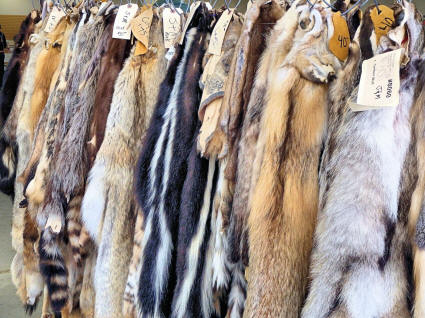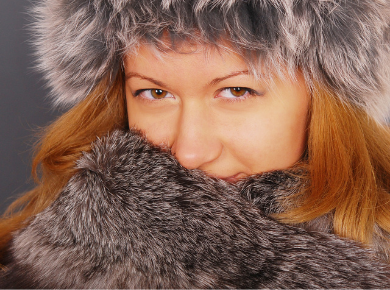Craftsmanship
Fur Garments - What it Takes
Fur is one of the oldest forms of clothing we know. It is still exceptional for its warmth, durability and beauty.
In an age of increasing standardization and mass production, the fur trade preserves skills and values which have been passed down through generations. Fur garments are the product of meticulous handcraft.
Each and every fur pelt is unique. As a result, the making of a fur coat can never really be "automated". From the production and dressing of pelts through to the design and manufacture of the finished garment, the fur trade is still characterized by small-scale, family-run businesses.

Furriers generally purchase their pelts - whether farmed or wild - at international auctions. Major North American auctions are held, several times a year, in Toronto, North Bay, New York and Seattle.
When the auction begins, buyers from the fashion centers of the world, speaking a dozen different languages, bid for each lot as it is presented. It takes a keen eye, strong nerves and a lifetime of experience to play this game. In the brief moments before the auctioneer's hammer falls, decisions must be made which will determine the rest of the furrier's year. This open, competitive system assures producers the highest possible price for their furs. Most major auction facilities are now owned directly by the producers.

From the auction house, pelts are sent for tanning and "dressing". The tanning of animal skins was one of Man's first explorations into the mysteries of applied chemistry. Modern fur dressers have perfected techniques for producing pelts which are supple, lustrous and truly long-lasting.
In addition to simple tanning, to preserve the leather, many other techniques are now used. The long outer guard hairs of a beaver pelt may be removed ("plucking"), and the thick soft underfur "sheared" to a uniform length. This luxurious velvet may then be dyed in a range of vibrant colors. Some of these processes require months and up to one hundred steps to complete.

When the dressed pelts reach the furrier's workshop, they must be sorted into well-matched "bundles", each with exactly the pelts needed to make one coal or jacket.
Each pelt is cut to the designer's pattern. The pieces are wet, stretched and tacked to a "blocking" table, to shape and soften them. Finally they will be sewn together.
With smaller pelts, especially mink, even more intricate work is required. Each pelt is sliced into narrow diagonal strips, and then meticulously sewn back together into a longer, narrower band. This process, know as "letting out", is one of the secrets of making a supple, flowing garment. A tine mink coat requires hundreds of tiny seams.
The furrier's craft is a painstaking process - there is no waste. Even small leftover pieces are collected, sorted by color and fur texture, and then sewn together into "plates" from which less expensive "pieced" garments will later be produced. Everything is used.
The tens of hours of skilled handwork through every stage of this process - from pelt production, to dressing, design and manufacturing - are the major component in the final cost of a fur garment. In all, it takes about one full year from the time trappers and farmers send their furs to auction, until the finished fur garment is ready for the consumer.

Furriers have traditionally concentrated their efforts on making the best quality garments possible, confident that protection of the primary resource is assured by government authorities, wildlife biologists, veterinarians and other competent scientists.
Environmental issues are of such importance today, however, that furriers themselves now seek to inform their customers about the vital role the fur trade plays in environmental conservation:
The fur trade is solidly based on the responsible use of a renewable natural resource. This is true for both farmed and wild furs.
The use of furs from wild species is strictly controlled, nationally and internationally. No furbearing species is endangered by the fur trade.
The fur trade provides income for thousands of North Americans in rural and remote regions where, often, there is little alternative employment.
Fur harvesting is fully compatible with environmental conservation and encourages the protection of wildlife habitat.
Living and working on the land, trappers serve as environmental "antennae" for a predominantly urban society - they are among the first to sound the alarm when wildlife habitat is threatened.
The fur trade is non-polluting, decentralized and is characterized primarily by small-scale family-run operations at all levels of the production chain.
Above all, the survival of the trade is directly dependent upon protection of habitat and sound management of wildlife populations.
At a time when we are all increasingly aware of the need to conserve scarce resources, furs are coming to be recognized as warm, lightweight and beautiful - but also extremely practical.